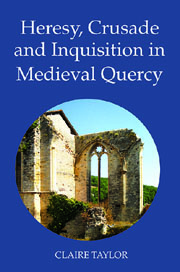Book contents
- Frontmatter
- Contents
- List of illustrations
- Dedication
- Acknowledgements
- Prefatory Note on Words
- List of Abbreviations
- Map 1 Medieval Quercy
- Map 2 Gourdon and its sphere
- The house of Gourdon
- Introduction
- 1 Investigating medieval Quercy: questions about sources
- 2 Medieval Quercy
- 3 War and its aftermath
- 4 ‘Heretical’ Quercy: the evidence gathered by c.1245
- 5 Heresy: a social and cultural life
- 6 Heresy and what it meant
- 7 The reshaping of Quercy
- Conclusion
- Bibliography
- Index
- YORK MEDIEVAL PRESS: PUBLICATIONS
Conclusion
Published online by Cambridge University Press: 05 February 2013
- Frontmatter
- Contents
- List of illustrations
- Dedication
- Acknowledgements
- Prefatory Note on Words
- List of Abbreviations
- Map 1 Medieval Quercy
- Map 2 Gourdon and its sphere
- The house of Gourdon
- Introduction
- 1 Investigating medieval Quercy: questions about sources
- 2 Medieval Quercy
- 3 War and its aftermath
- 4 ‘Heretical’ Quercy: the evidence gathered by c.1245
- 5 Heresy: a social and cultural life
- 6 Heresy and what it meant
- 7 The reshaping of Quercy
- Conclusion
- Bibliography
- Index
- YORK MEDIEVAL PRESS: PUBLICATIONS
Summary
After Raimond VII died in 1249 Quercy went to the crown as had been agreed in 1229. Royal commissioners obtained new oaths from the consuls of Castelsarrassin, Montauban and Moissac, and from lords such as Dorde Barasc, Fortanier de Gourdon and Bertrand de Cardaillac. Alphonse divided the administration of Languedoc into four regions, Quercy and the Agenais comprising one, with four new seneschals. In 1251 Alphonse of Poitiers, the king's brother, and Jeanne de Toulouse, the dead count's daughter, toured Quercy, visiting Lauzerte and Montauban in particular. This is tantalizing, as Catharism survived at Montauban and Caussade in a small way into the 1250s. The royal couple may indeed have ‘seen’ a heretic, ‘but without knowing them to be such’.
In accounting for the rise and fall of heresy in Quercy, I have argued the following.
On the nature of heresy in Quercy
Heresy was partially constructed and understood through the categories of belief and activity imposed on it by inquisitorial records, influenced in their turn by polemical treatises and early manuals for inquisitors. But it was nonetheless a reality external to the texts. I have tried to demonstrate that the focus of the inquisitor on investigation before punishment undermines the notion that his methodology essentially entailed him using such received knowledge of Catharism and Waldensianism to reproduce and confirm that same knowledge through his practice in the courtroom.
- Type
- Chapter
- Information
- Heresy, Crusade and Inquisition in Medieval Quercy , pp. 227 - 236Publisher: Boydell & BrewerPrint publication year: 2011



